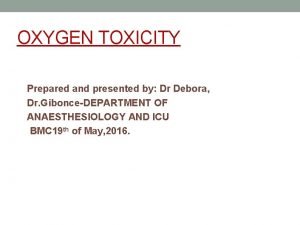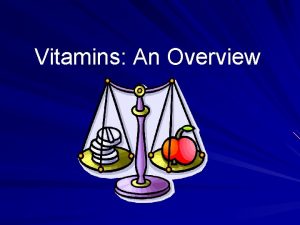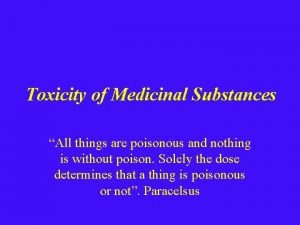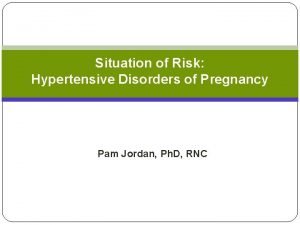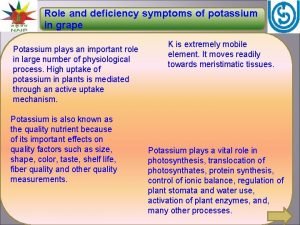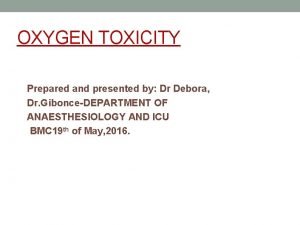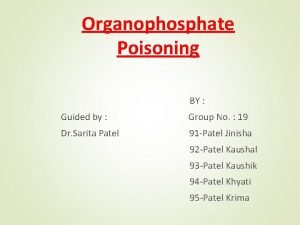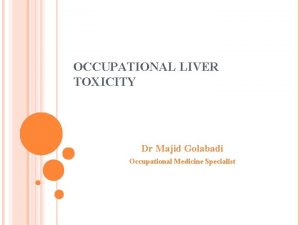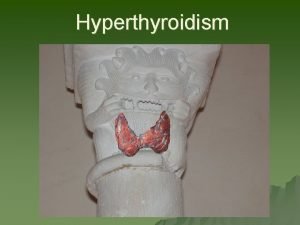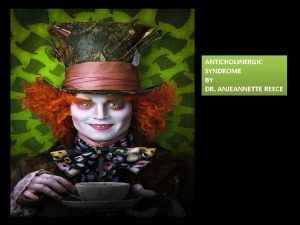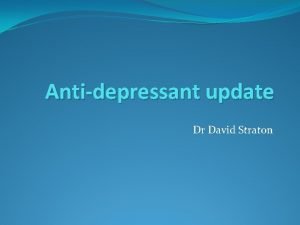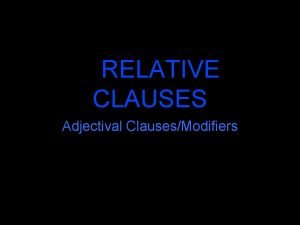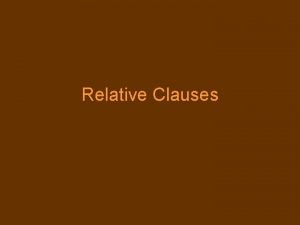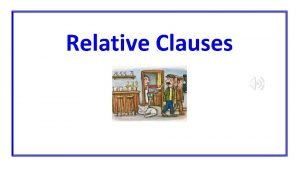RELATIVE TOXICITY OF CITALOPRAM AND OTHER SSRIs IN






















- Slides: 22

RELATIVE TOXICITY OF CITALOPRAM AND OTHER SSRIs IN OVERDOSE GK Isbister 1, 2, IM Whyte 1, 2, AH Dawson 1, 2 1 Department of Clinical Toxicology, Newcastle Mater Hospital, 2 Discipline of Clinical Pharmacology, University of Newcastle

Background • Concern regarding citalopram overdose: – reports of fatal cases – cardiotoxicity and seizures with massive OD • Case series (Sweden) suggested: – prolonged QTc if > 600 mg – seizures – no deaths CLASS OR INDIVIDUAL DRUG EFFECT ?

Aim To define : • spectrum of toxicity of SSRI overdose • relative toxicity of individual SSRIs – to investigate the cardiac toxicity of the SSRIs in overdose – to investigate the serotonergic effects of SSRIs in overdose

Methods • Cohort of inpatient overdose admissions – Prospective data collection • Inclusions : – All SSRI overdoses presenting to Hunter Area Toxicology Service (HATS) • Exclusions : – more than one SSRI ingested – coingestion of TCA, venlafaxine, nefazodone

Methods • Cases included were: – SSRI dose > maximum daily dose – SSRI alone OR – coingestant with no known effect on QT • Only one ECG/admission per patient included: – ECG with longest QT used to select cases

Methods • Control group • Overdoses of medications with no known cardiotoxicity, or affect the QT or QRS interval – paracetamol/codeine – diazepam – temazepam

Methods • Electrocardiograph: – QTc – QRS • Clinical Features: – Incidence of arrhythmia – Bradycardia (HR < 60 bpm) – Tachycardia (HR > 100 bpm) – Hypotension (systolic BP < 90 mm. Hg)

Electrocardiographic Analysis • RR, QT and QRS measured manually on ECGs • QTc from Bazett’s formula • QTc > 440 msec was defined as ABNORMAL

Analysis • Statistical analysis : – Comparison of proportion QTc > 440 msec – Comparison of mean/median QTc (ANOVA) • Logistic regression – Dependent variable QTc>440 msec – Independent variable : age, sex, DDD, time to ingestion, SSRI type – Forward stepwise logistic regression modelling

Results • Poisoning admissions to HATS: 8909 cases • 413 single SSRI admissions: – 118 coingested cardiotoxic drugs – 30 had no ECG done (10%) • 265 admissions with 312 ECGs • 236 ECG/patients were included • 318 Control patients

Results 236 ECG/patients were included: Citalopram Sertraline Paroxetine Fluvoxamine 32 82 70 39 13

Median ECG parameters Citalopram Control Group Fluox Fluvox Parox P value * Sert * ANOVA of medians (5 SSRIs and controls);

QTc > 440 msec • 66% of citalopram overdoses with QTc > 440 msec • Calculated the odds ratio of QTc > 440 msec compared to control overdoses • THEN did logistic regression


Drug Ingested Controls Fluoxetine Fluvoxamine Paroxetine Citalopram Sertraline Age DDD Gender 1. 00 0. 38 1. 10 3. 79 1. 17 1. 02 1. 01 Males 1. 00 Females 2. 48 0. 482 - 2. 090 0. 080 - 1. 787 0. 625 - 1. 945 1. 672 - 8. 591 0. 657 – 2. 072 1. 004 – 1. 028 0. 996 - 1. 022 0. 993 0. 220 0. 736 0. 001 0. 599 0. 011 0. 168 1. 643 – 3. 730 <0. 001

Clinical Effects Control Fluox Fluvox Parox Cital Sert P value Cardiovascular Effects Arrhythmia - 3% 0% 0% 3% 0% 0. 504 * Bradycardia 7% 10% 8% 9% 13% 6% 0. 821 Tachycardia 17% 15% 0% 13% 22% 0. 224 Hypotension - 0% 0% 0% 1% 0% 0. 191 *

Citalopram overdose : Admission 6 hours after overdose

Discharge 38 hours after overdose

Summary of Cardiac Toxicity • Citalopram has significant cardiotoxicity: – Median QTc significantly longer – Median QT significantly longer – Proportion of QTc>440 msec significantly greater – Almost 4 times the risk of QTc prolongation compared to control – Potential for arrhythmias/bundle branch block • Other SSRIs – Appears to be much less risk

Limitations • One ECG for each patient, but: – Compared to controls (overdose controls) – Adjusted for baseline; female significant • QTc is marker of cardiotoxicity only, but: – Poison Severity Score : moderate – FDA : uses median QTc and proportion of abnormal QTc in evaluation

Recommendations • All patients with citalopram overdoses > 60 mg should have serial 12 lead ECGs and be monitored until the QTc < 440 msec. • Citalopram should be used with care in patients with a history of cardiac disease or arrhythmias, in particular bradycardia or known long QT syndrome

Acknowledgements • Steve Bowe : statistical analysis • Toni Nash and Debbie Whyte for data entry • Stuart Allen for data extraction
 Citalopram andar
Citalopram andar Oxygen toxicity
Oxygen toxicity Relative clauses and relative pronouns stage 15
Relative clauses and relative pronouns stage 15 Types of relative clauses
Types of relative clauses Relative pronouns examples
Relative pronouns examples B6 toxicity symptoms
B6 toxicity symptoms Vitamin d toxicity
Vitamin d toxicity Definition of chronic toxicity
Definition of chronic toxicity Vitamin d toxicity
Vitamin d toxicity Magnesium sulfate toxicity level
Magnesium sulfate toxicity level Plant name
Plant name Oxygen toxicity
Oxygen toxicity Organophosphate poisoning
Organophosphate poisoning Hepatic toxicity
Hepatic toxicity Lithium toxicity
Lithium toxicity Thyroid resistance syndrome
Thyroid resistance syndrome Ghs pictogram depicts which hazard
Ghs pictogram depicts which hazard Definition of chronic toxicity
Definition of chronic toxicity Digoxin mechanism of action
Digoxin mechanism of action Apap
Apap Anticholinergic syndrome
Anticholinergic syndrome Alcohol toxicity
Alcohol toxicity Roles of vitamin c
Roles of vitamin c

